US Currency in Circulation & US Gold Reserves
I have an important announcement to make. In Barron's 21 March 2011 issue, the Federal Reserve announced that for the first time in history, the sum total of all US paper dollars and base-metal coins in circulation (CinC) has exceeded $1 trillion dollars. For a proper perspective of exactly what this means, CinC in January, 1920 was only 4.48 billion dollars. Ninety years ago, two silver quarters could buy a pork-chop supper for a family of 4 with vegetables & potatoes, according to my father. Do you think I'm kidding? Next time an old movie from the depression era is shown on Turner Classic Movies, check the prices for meals posted on the walls of diners. A dollar, spent frugally could buy a meal for two, and still leave a nice $0.10 tip.
So, you see these trillion dollars didn't pop into existence overnight, and that's why I cringe every time I hear someone in the media complaining in 2011 that the Federal Reserve is "printing money." Well for everyone's information, with rare exception, this has been true for the past 97 years; and shame on any public official, or member of the financial media who finds this newsworthy. This is being done in the full light of day, as a matter of public record published weekly in Barron's. These increases in paper money and base-metal coins (CinC) above and beyond the ability of the US Treasury to ever redeem in gold, in complete disregard to the US Constitution and international law, have been routinely reported by the Federal Reserve since its creation.
Other than myself, it seems no one uses CinC in their market research anymore. But I like it because coins and paper money are something easy to measure that we can all see and understand. Tracking the expansion of CinC provides a simple statistic we can use when discussing the money supply. The academic and banking elites prefer using arcane statistics, such as the monetary aggregates of M1 & M2, which include dollars created by credit devices such as bank loans, "MZM" (money at zero maturity), or the "Monetary Base" compiled by the St. Louis Fed. They are all used to measure the number of dollars in existence, and they are all different.
How is this possible? Well, at the highest levels of politics and finance, the dollar is not so much a thing, as it is a means to an end used by the ever expanding bureaucracy in Washington that has no intention of going away anytime soon. It's to their advantage to keep the definition of what a dollar is, nebulous. A few years back, Representative Ron Paul, during congressional testimony, asked Doctor Greenspan exactly what a dollar was - and Doctor Greenspan told Mr. Paul that no one, including him, really knew.
However, before the creation of the US Federal Reserve, in the days when the public's finances could be audited with the same degree of certainty as any public corporation, the US dollar was still a clearly defined unit of account. Below is a photo of twenty (in no uncertain terms), dollars as was circulating during the gold standard.
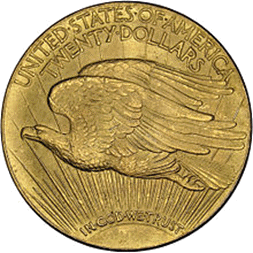
What we see above is the reverse side of the US Double Eagle, $20 gold piece. At the time this coin circulated as money, a paper $20 bill was not actually "money," but rather a claim check on a $20 gold coin owed to holder of the bill. Monetary policy was simple in the days before the Federal Reserve: the US Treasury didn't issue more paper dollars than the US Mint had minted gold coins. Managing the US dollar was simple, possibly as simple as having a low level Treasury official taking a few hours a week to balance the debit and credit sides of the dollar's balance sheet, with paper dollars clearly a liability.
Courtesy of THE PRIVATEER, an exceptional political and economic letter, here is a 1913 $50 gold certificate. It looks remarkably like our current $50 Federal Reserve Note.
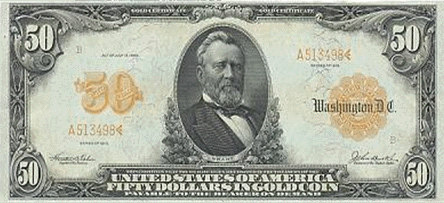
It may look similar, but there was one significant difference, as we can see below.

Back in 1913, the ability of any holder of this note to demand $50 in gold coin prevented Washington from "injecting" unbacked dollars into the economy. To do so when gold coins were money, and paper dollars were only claims on money, would have caused a panic out of the US Treasury's paper dollars, and into the US Mint's gold coins when word got around that the US Treasury had defaulted on its obligations in the money market.
These samples are from THE PRIVATEER'S webpage on the history of US paper money, a short read, well worth your time before continuing my article.
During the gold standard, the US Government didn't make the decision of how many gold coins to put into circulation. While repellent to the ears of Doctor Bernanke, and maybe to yours as well, the volume of money (gold coin) in circulation was determined by grizzled-old prospectors with two mules and enough beans, bacon and coffee for the round trip into the desert seeking gold "in them-thar-hills." After finding gold, (and prospectors usually didn't), they, or large publically traded gold mining companies like Homestake Mining, or any private citizen with old gold jewelry, could have their gold assayed and minted into US Gold coins by the US Government at no cost and with no questions asked.
Uncle Sam has always kept track of how many coins were minted, as they still do today. But during the gold standard, the number of gold coins minted determined how many paper dollars the government could issue. How many gold coins were minted was limited by the amount of gold submitted to the various US Mints, by gold mining companies and private citizens. Banks, like everyone else, had to compete for the limited supply of dollars (gold) available from the public. Interest rates under the gold standard were determined by the actual supply and demand for money, not set by some ivory tower academic's idea of what will best serve the economy (or best serve the private banks). The creation of the Federal Reserve, and the demonetization of gold turned this prudent, time tested system on its head.
An important fact about the gold standard that is not understood today is that the US Government's gold wasn't stored in Fort Knox. The US Treasury DID keep sufficient gold on hand for redeeming its paper money obligations, but then, so did local banks. Before 1933, when President Roosevelt illegally called in the US Gold supply from its citizens for the benefit of the insolvent Federal Reserve System, it was a well known fact that widows & orphans also held their savings in gold coins. But all that changed in 1933, when plans for a gold bullion depository were made.
Below are some details of the US Treasury's gold depository at Fort Knox from Global Security.
"The Depository was completed in December 1936 at a cost of $560,000. Building materials used included 16,000 cubic feet of granite, 4,200 cubic yards of concrete, 750 tons of reinforcing steel, and 670 tons of structural steel. The first gold was moved to the Depository by railroad in January 1937. That series of shipments was completed in June 1937" -- Global Security
All this material, plus the significant labor cost required to construct it, and contracts with architects for the building plans for a mere $560,000 (1937) dollars! At the height of Congress's "affordable housing" bubble, the Bunny and I would take tours of new homes in upscale neighborhoods. We couldn't find a single new house, faced with brick available for $560,000 (2006) dollars because Washington had locked up the nation's gold in Fort Knox, and inflated CinC to grotesque proportions since 1937 with unbacked fiat paper dollars. Replacing the grizzled-old prospectors with well-scrubbed academics, schooled in the dark arts of central banking had unforeseen consequences. This may sound funny, but it's also true!
Today, we see the world's central banks once again beginning to accumulate gold for a "monetary reserve," as if the gold stored in their vaults could somehow redeem their monetary sins committed with paper, ink and computer hard drives. It can't, not until the central banks' gold horde is minted into coins, and allowed to circulate freely as money; gold coins that can be exchanged at face value, and on demand with its paper notes, which would once again become valid money substitutes.
Remember back in the late 1990s, when the ECB let the world know that its new Euro had a 15% gold backing? This sounded good, however: because the paper euro was never fully convertible into gold coin, ten years and a few European banking mishaps later, we can be sure the gold backing of the euro is now something less than 15%! Currently, central banks absolutely refuse to allow gold to circulate as money, as circulating gold coins would critically limit their ability to print paper money in sufficient volume to paper over the political follies of their patrons.
Let's look at the history of the US CinC and the US Treasury's gold reserves from 1925 to 2011; first, a chart covering 1925-37. In part one of this series, I showed how the 1920s was a time of monetary excesses, using bank credit. But as we see below, from 1925 to 1931, the US Treasury and the Federal Reserve continued to faithfully respect the law, by not printing more paper dollars than they had gold coins in circulation. This changed in 1931 with President Hoover, who began circulating paper gold certificates (Blue Plot) in excess of gold coins (Red Plot).
The results were immediate, and very evident in the chart below: a run on US gold began. This aspect of the Great Depression is usually omitted in the history books, but nonetheless documented weekly in Barron's magazine during the 1930s. I love those guys! President Roosevelt's solution to the monetary crisis begun by President Hoover, was to call in all gold coin held by US citizens for $20.67 an ounce (or go to jail), make the currency no longer redeemable for bullion, revalue gold to $35 an ounce (a hefty 70% tax on savings), and melt the gold coins into 400 ounce bricks for storage in Fort Knox, a place where honest money couldn't interfere with Roosevelt's "policy" of monetary inflation.
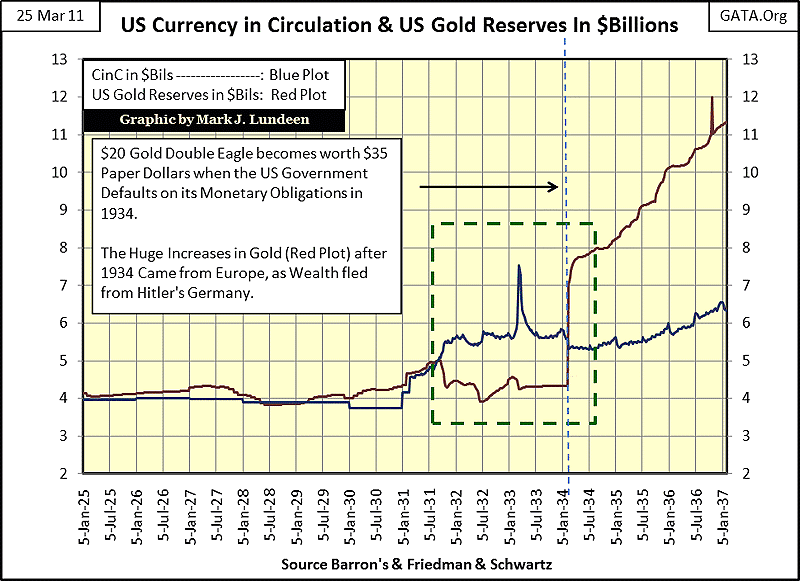
Economic historians seem to focus on the price deflation during the 1930s. But then as now, when economic hard times are the result of excess credit creation by the banking system (the recent housing bubble is a perfect example), price declines in inflated assets are unavoidable. Economists call such a situation, "pushing on a string," when decreases in interest rates no longer produce an increase in demand for "dollars" from the banking system. That's a nice way of saying that the Federal Reserve created so much debt, that a bubble was created which finally bankrupted the banking system's clients' personal, and business finances, thus corrupting the banking systems reserves with illiquid loans that can't be paid back. This also accurately describes the process used by central banks to create the current problems in Europe and in the United States.
What seemed strange to me while reading those old issues of Barron's, was that Barron's was more concerned by the huge inflation of the 1930s than declining prices. Unlike today, inflation was well understood as increases in the money supply. Clearly, eighty years ago the staff at Barron's was closely following the Red Plot above, not the 1930s' declining real estate and consumer prices. Where had this gold come from? Barron's didn't seem to know. But if you had read the link I provided from Global Security on Fort Knox, we now know that it came from Europe, whose wealth was fleeing Hitler. Politicians such as the UK's Prime Minister Neville Chamberlain may have believed "peace in our time," was possible, but banks and financial ministers all over Europe were shipping their gold to the United States, just in case.
Next is a chart for 1925 to 1961, which includes the period from the ratification of the Bretton Wood's Monetary Accords (BWMA) in 1945, to the inauguration of President Kennedy. In other words, we are looking at the US dollar during the Truman and Eisenhower administrations. The BWMA had fixed the price of gold at $35 dollars an ounce. With the classic gold standard still fresh in everyone's mind, both the public and bankers around the world took this to mean that the US Government was promising never to issue more than 35 paper dollars for each ounce of gold held in Fort Knox, as the US Senate ratified the international monetary treaty into law.
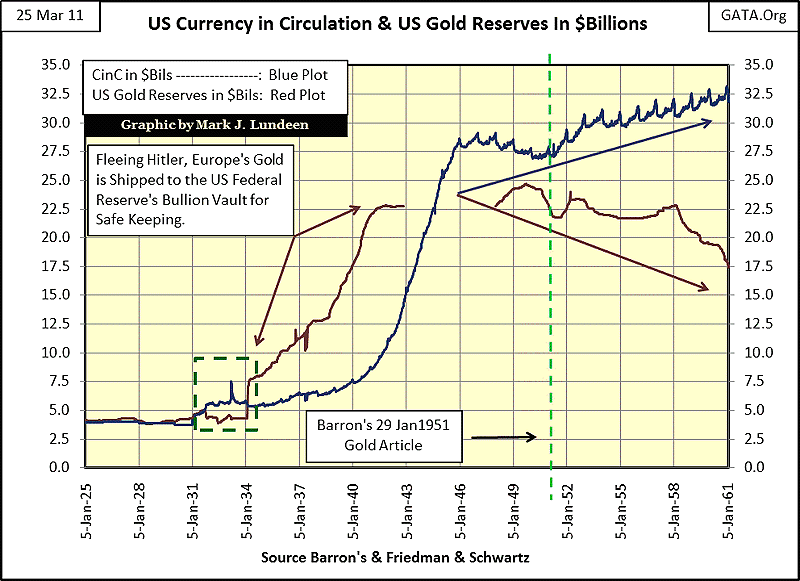
Ironically, it was Truman, the Democrat, who seemed to take the BWMA seriously, and actually withdrew paper dollars from circulation, closing the gap between the paper dollar (Blue Plot) and its gold reserves (Red Plot). This is not to say that President Truman was an advocate of sound money, as Barron's noted in 1950:
"We hope that the government of the United States, despite the big spenders, and the gold tinkerers, maintain a sound dollar, a dollar worth saving, a dollar worth earning, and a dollar that can be traded in any part of the civilized world." -- Barron's World at Work, 02 January 1950 issue, Front Page
Eisenhower, the Republican, who soon after he assumed the presidency, accelerated the increase of CinC above what the Treasury's gold reserve could justify.
"The long years of inflation, it would thus appear, are coming home to roost. In such circumstances other governments have chosen some of the classic remedies available, including tighter credit and fiscal policies. But this country, even under the G.O.P (Republican Party), has not yet nerved itself to swallow so bitter a pill. --- "Yet in the end all nations, no matter how rich or powerful must play the game by the rules or suffer the consequences. It's time Washington took heed of its dwindling stack of chips." (U.S. gold bullion reserves) -- Barron's Editorial: 20 September 1954
The results were predictable, and seen in the decline in the US Gold Reserve's Red Plot. Europeans, the actual owners of much of "America's gold," as well as anyone who cared to follow this drama of gold bullion and green ink in the statistical pages of Barron's, could see that week after week, the US Government was over-issuing paper dollars. This was unacceptable to France, who began cashing in their paper dollars received in trade, for gold bullion at the US Treasury at the rate fixed in the BWMA treaty of $35 dollars per ounce. But like Truman and Eisenhower, the French, too, were playing games in the gold market:
"Paris - The Paris gold market is worrying the U.S. Treasury. In recent months, the free gold price has been 20% to 30% higher than the $35 an ounce: dollars are therefore, cheap in terms of gold. To depress the gold price, the French treasury has been selling gold for dollars. Having acquired the gold from the U.S. or through the European Payment Union, at $35 an ounce, it (France) reaps tidy arbitrage profits. Although the French support the dollar, our Treasury resents the way they have turned the gold market into a source of dollar gains." -- Barron's World at Work Column: 29 January 1951
This 1951 clipping from Barron's is the earliest evidence I've found that the US Government has manipulated the price of gold below its free market price. They've been doing for decades, and Washington resents anyone who takes advantage of the fact that it issues too many paper dollars to make a profit. I guess there's a "policy" somewhere in Washington that American tax-payers and foreigners are to take their inflationary losses like men. So, what is the free market price of gold? From looking at my chart above, in 1951 it was pretty much determined by how many paper dollars were issued by the US Federal Reserve in excess of the BWMA standard of $35 paper dollars for every 1 dollar held by the US Treasury. I believe there is real fear at the highest levels of "policy" this may once again become a reality in the price of gold.
Why did "Nixon close the gold window?" The answer to that question is that he was FORCED to by the frivolous money printing during the Kennedy and Johnson administrations, Bretton Woods be damned. The War in Vietnam, Space Race with the USSR, and the "Great Society" social programs under Johnson (and since) were far too costly to ever be financed through taxation, but Kennedy and Johnson were men of big dreams. By 1968, the French and Swiss were draining the US Treasury gold reserves of gold at $35 an ounce, using dollars received in foreign exchange. When Nixon took office in 1969, the Treasury was already hemorrhaging gold bullion. By 1971, the US Treasury had lost 58% of its 1949 gold reserves, forcing Nixon to close the gold window, or devalue the dollar to $198 for an ounce of US Gold and return to honest money. To our great misfortune, he chose to close the gold window.
Within the dashed box in the chart below, we see the predictable results of paper money inflation from 1951-71: a run on US Gold - again! But remember, much of this gold had been transferred from Europe during the 1930s to protect it from Hitler. Starting in 1958, it once again took flight, this time fleeing the grasping paws of American politicians. Historians make much of France delivering dollars to the US Treasury and taking "America's Gold" home. But they seem to have completely forgotten just where all that gold came from in the 1930s!
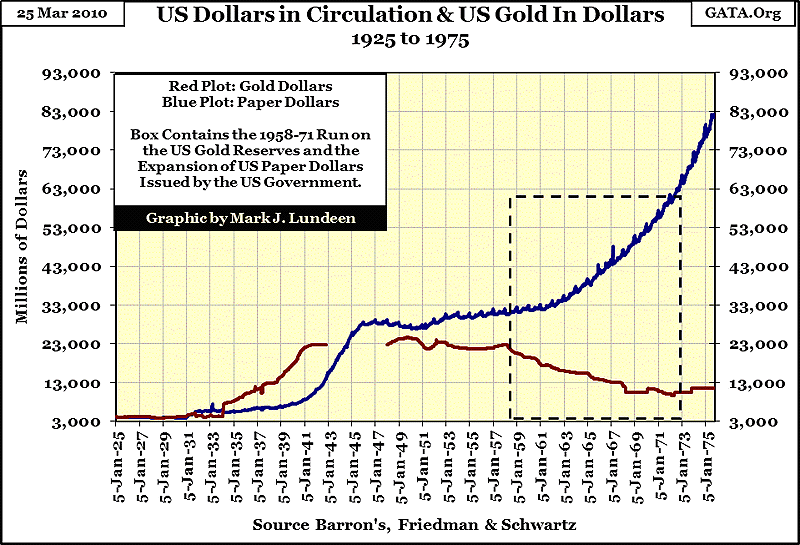
The table below provides specifics on the ratio of paper to gold dollars from 1945 to the present. Keynesian-economist hacks continue to blame the post WW2 dollar problems on gold. But anyone who actually bothers to look at the historical record, as shown in this article, will understand that the real problem is caused by politicians who aspire to make a name for themselves, seeking a place in history, but lacking sufficient dollars than could be provided honestly through taxation or borrowing.
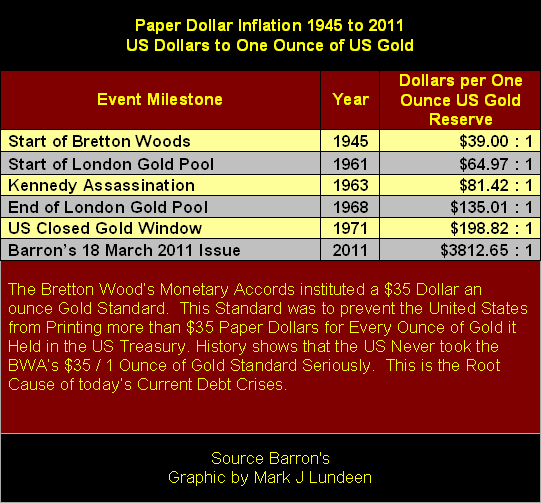
Bretton Woods is still the law of the land, and so too is the $35 gold peg. Nixon's Presidential Executive Order cannot repeal an international treaty, ratified by the US Senate. That, plus the IMF and World Bank, both creations of Bretton Woods, still have legal standing in the US. Clearly, except for the $35 to one ounce of gold peg, Bretton Woods is alive and well. The Keynesian-hack economists' role in all this is to play the monetary whore for Washington politicians. If becoming a financial strumpet will take them far away from a classroom full of 19 to 26 year old students, to a seat at a table of immense power, many Keynesians are willing to make that sacrifice.
In case you're wondering what happened to the US Dollar since 1975, here is the last chart of the series. The Red Plot for the US gold reserves is still there; you just have to look closely at the bottom of the chart. For anyone to say in March 2011 that gold and silver at current prices are overvalued, they must either be ignorant, a scoundrel, or quite possibly both.
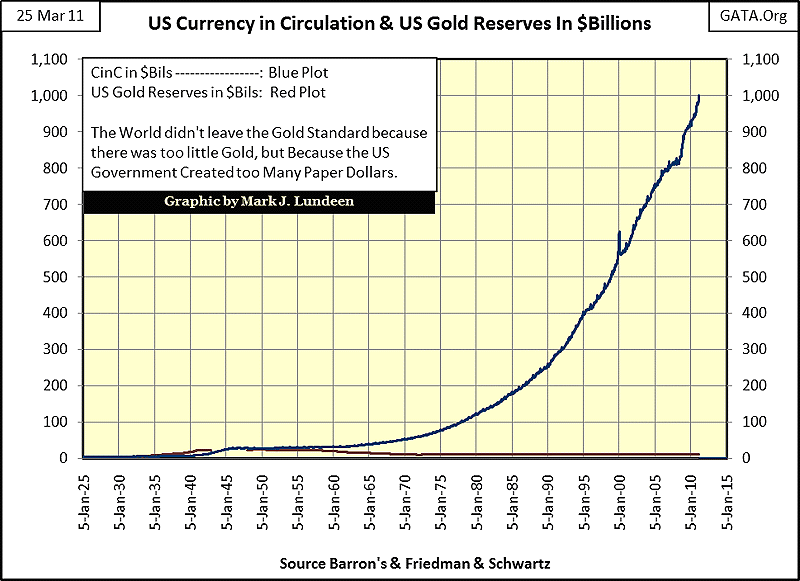
Since the creation of the Federal Reserve in 1913, the management of the US dollar has always favored Washington's political class and the New York banking elite, at great cost to commerce and the general population. Entire financial markets in derivatives have been created that feed off the Federal Reserve's toxic waste products of increased volatility risks in:
- Currency rates
- Interest rates
- Asset & commodity prices
- Sovereign, municipal, and corporate debt
These post Bretton Woods' derivative markets, where industry and fiduciaries are now forced to hedge economic uncertainties absent when gold was used as money, are parasitic markets, contributing nothing to actual economic growth. But in the 40 years since Nixon closed the US Treasury's gold window, derivative markets designed to hedge volatility risks inherent in a corrupted currency have become the largest financial markets in the world. You have to look no further than the chart above to see why this is so.
















